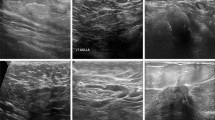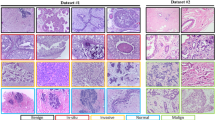Abstract
Breast cancer, a widespread global disease, represents a significant threat to women’s health and lives. Many researchers have proposed computer-aided diagnosis systems for classifying breast cancer. The majority of the approaches primarily utilize deep learning methods, which overlook the crucial necessity of incorporating both local information for precise tumor detection. In addition, available breast cancer datasets are imbalanced in nature. Therefore, this paper presents the hybrid breast network (HBNet) for detection of breast cancer, designed to address two critical challenges: class imbalance and incorporation of both global and local information in achieving precise tumor classification. To overcome the problem of class imbalance, HBNet incorporates the borderline synthetic minority oversampling technique. Simultaneously, it employs a feature fusion approach to combine deep and handcrafted features extracted by utilizing ResNet50 and HOG which incorporates global and local information. Moreover, the proposed method integrates the block-matching and 3D denoising filter to effectively eliminate multiplicative noise that has enhanced the performance of the system. The proposed HBNet is evaluated with BUSI and UDIAT datasets and achieved an average accuracy of 95.824% and 90.37%, respectively.











Similar content being viewed by others
Explore related subjects
Discover the latest articles, news and stories from top researchers in related subjects.Data availability
Data have been incorporated into the study.
References
Abhisheka B, Biswas SK, Purkayastha B (2023) A comprehensive review on breast cancer detection, classification and segmentation using deep learning. Arch Comput Methods Eng 30:1–30
American Cancer Society. https://www.cancer.org/cancer/types/breast-cancer/understanding-a-breast-cancer-diagnosis/breast-cancer-survival-rates.html
World Health Organization (2021). https://www.who.int/news-room/fact-sheets/detail/breast-cancer
Nassif AB, Talib MA, Nasir Q, Afadar Y, Elgendy O (2022) Breast cancer detection using artificial intelligence techniques: a systematic literature review. Artif Intell Med 127:102276
Shakeel PM, Tolba A, Al-Makhadmeh Z, Jaber MM (2020) Automatic detection of lung cancer from biomedical data set using discrete AdaBoost optimized ensemble learning generalized neural networks. Neural Comput Appl 32:777–790
Pedada KR, Rao B, Patro KK, Allam JP, Jamjoom MM, Samee NA (2023) A novel approach for brain tumour detection using deep learning based technique. Biomed Signal Process Control 82:104549
Oza P, Sharma P, Patel S, Kumar P (2022) Deep convolutional neural networks for computer-aided breast cancer diagnostic: a survey. Neural Comput Appl 34(3):1815–1836
Schwartz D, Sawyer TW, Thurston N, Barton J, Ditzler G (2022) Ovarian cancer detection using optical coherence tomography and convolutional neural networks. Neural Comput Appl 34(11):8977–8987
Abhisheka B, Biswas SK, Purkayastha B, Das D, Escargueil A (2023) Recent trend in medical imaging modalities and their applications in disease diagnosis: a review. Multim Tools Appl, 1–36
Ranjbarzadeh R, Dorosti S, Ghoushchi SJ, Caputo A, Tirkolaee EB, Ali SS, Arshadi Z, Bendechache M (2022) Breast tumor localization and segmentation using machine learning techniques: overview of datasets, findings, and methods. Comput Biol Med 152:106443
Rana M, Bhushan M (2023) Machine learning and deep learning approach for medical image analysis: diagnosis to detection. Multim Tools Appl 82(17):26731–26769
Yamashita R, Nishio M, Do RKG, Togashi K (2018) Convolutional neural networks: an overview and application in radiology. Insights Imaging 9:611–629
Teodoro AA, Silva DH, Saadi M, Okey OD, Rosa RL, Otaibi SA, Rodríguez DZ (2021) An analysis of image features extracted by CNNs to design classification models for COVID-19 and non-COVID-19. J Signal Process Syst 91:1–13
Saba T, Abunadi I, Sadad T, Khan AR, Bahaj SA (2022) Optimizing the transfer-learning with pretrained deep convolutional neural networks for first stage breast tumor diagnosis using breast ultrasound visual images. Microsc Res Tech 85(4):1444–1453
Salama WM, Elbagoury AM, Aly MH (2020) Novel breast cancer classification framework based on deep learning. IET Image Proc 14(13):3254–3259
Sethy PK, Behera SK (2022) Automatic classification with concatenation of deep and handcrafted features of histological images for breast carcinoma diagnosis. Multim Tools Appl 81(7):9631–9643
Gao F, Wu T, Li J, Zheng B, Ruan L, Shang D, Patel B (2018) SD-CNN: a shallow-deep CNN for improved breast cancer diagnosis. Comput Med Imaging Graph 70:53–62
Atrey K, Singh BK, Bodhey NK (2023) Multimodal classification of breast cancer using feature level fusion of mammogram and ultrasound images in machine learning paradigm. Multim Tools Appl 83:1–22
Huang Q, Wang D, Lu Z, Zhou S, Li J, Liu L, Chang C (2023) A novel image-to-knowledge inference approach for automatically diagnosing tumors. Expert Syst Appl 229:120450
Qian N, Jiang W, Guo Y, Zhu J, Qiu J, Yu H, Huang X (2023) Breast cancer diagnosis from contrast-enhanced mammography using multi-feature fusion neural network. Eur Radiol 34:1–11
Razali NF, Isa IS, Sulaiman SN, Karim NKA, Osman MK (2023) CNN-wavelet scattering textural feature fusion for classifying breast tissue in mammograms. Biomed Signal Process Control 83:104683
Chen H, Ma M, Liu G, Wang Y, Jin Z, Liu C (2023) Breast tumor classification in ultrasound images by fusion of deep convolutional neural network and shallow LBP feature. J Digit Imaging 36:1–15
Luo Y, Lu Z, Liu L, Huang Q (2023) Deep fusion of human-machine knowledge with attention mechanism for breast cancer diagnosis. Biomed Signal Process Control 84:104784
Rahman MM, Khan MSI, Babu HMH (2022) BreastMultiNet: a multi-scale feature fusion method using deep neural network to detect breast cancer. Array 16:100256
Sannasi Chakravarthy S, Bharanidharan N, Rajaguru H (2022) Multi-deep CNN based experimentations for early diagnosis of breast cancer. IETE J Res 69:1–16
Cruz-Ramos C, García-Avila O, Almaraz-Damian J-A, Ponomaryov V, Reyes-Reyes R, Sadovnychiy S (2023) Benign and malignant breast tumor classification in ultrasound and mammography images via fusion of deep learning and handcraft features. Entropy 25(7):991
Khan SI, Shahrior A, Karim R, Hasan M, Rahman A (2022) MultiNet: a deep neural network approach for detecting breast cancer through multi-scale feature fusion. J King Saud Univ-Comput Inf Sci 34(8):6217–6228
Liu Y, Ren L, Cao X, Tong Y (2020) Breast tumors recognition based on edge feature extraction using support vector machine. Biomed Signal Process Control 58:101825
Stephan P, Stephan T, Kannan R, Abraham A (2021) A hybrid artificial bee colony with whale optimization algorithm for improved breast cancer diagnosis. Neural Comput Appl 33(20):13667–13691
Rana M, Bhushan M (2023) Classifying breast cancer using transfer learning models based on histopathological images. Neural Comput Appl 35(19):14243–14257
Goceri E (2022) Evaluation of denoising techniques to remove speckle and Gaussian noise from dermoscopy images. Comput Biol Med 152:106474
Noor A, Zhao Y, Khan R, Wu L, Abdalla FY (2020) Median filters combined with denoising convolutional neural network for Gaussian and impulse noises. Multim Tools Appl 79:18553–18568
Jiang C, Lv W, Li J (2023) Protein–protein interaction sites prediction using batch normalization based CNNs and oversampling method borderline-smote. IEEE/ACM Trans Comput Biol Bioinform 20:2190–2199
UDIAT (2017). http://www2.docm.mmu.ac.uk/STAFF/m.yap/dataset.php)
Al-Dhabyani W, Gomaa M, Khaled H, Fahmy A (2020) Dataset of breast ultrasound images. Data Brief 28:104863
He K, Zhang X, Ren S, Sun J (2016) Deep residual learning for image recognition. In: Proceedings of the IEEE conference on computer vision and pattern recognition, pp 770–778
Liu S, Deng W (2015) Very deep convolutional neural network based image classification using small training sample size. In: 2015 3rd IAPR Asian conference on pattern recognition (ACPR). IEEE, pp 730–734
Szegedy C, Vanhoucke V, Ioffe S, Shlens J, Wojna Z (2016) Rethinking the inception architecture for computer vision. In: Proceedings of the IEEE conference on computer vision and pattern recognition, pp 2818–2826
Huang G, Liu Z, Van Der Maaten L, Weinberger KQ (2017) Densely connected convolutional networks. In: Proceedings of the IEEE conference on computer vision and pattern recognition, pp 4700–4708
Pomponiu V, Hariharan H, Zheng B, Gur D (2014) Improving breast mass detection using histogram of oriented gradients. In: Medical imaging 2014: computer-aided diagnosis, vol 9035. SPIE, pp 465–470
Wei M, Du Y, Wu X, Su Q, Zhu J, Zheng L, Lv G, Zhuang J (2020) A benign and malignant breast tumor classification method via efficiently combining texture and morphological features on ultrasound images. Comput Math Methods Med 2020:5894010
Cui W, Peng Y, Yuan G, Cao W, Cao Y, Lu Z, Ni X, Yan Z, Zheng J (2022) FMRNet: a fused network of multiple tumoral regions for breast tumor classification with ultrasound images. Med Phys 49(1):144–157
Das S, Biswas SK, Purkayastha B (2023) Automated Indian sign language recognition system by fusing deep and handcrafted feature. Multim Tools Appl 82(11):16905–16927
Das D, Biswas SK, Bandyopadhyay S (2023) Detection of diabetic retinopathy using convolutional neural networks for feature extraction and classification (DRFEC). Multim Tools Appl 82(19):29943–30001
Author information
Authors and Affiliations
Corresponding author
Ethics declarations
Conflict of interest
The authors declare that they have no conflict of interest.
Additional information
Publisher's Note
Springer Nature remains neutral with regard to jurisdictional claims in published maps and institutional affiliations.
Rights and permissions
Springer Nature or its licensor (e.g. a society or other partner) holds exclusive rights to this article under a publishing agreement with the author(s) or other rightsholder(s); author self-archiving of the accepted manuscript version of this article is solely governed by the terms of such publishing agreement and applicable law.
About this article
Cite this article
Abhisheka, B., Biswas, S.K. & Purkayastha, B. HBNet: an integrated approach for resolving class imbalance and global local feature fusion for accurate breast cancer classification. Neural Comput & Applic 36, 8455–8472 (2024). https://doi.org/10.1007/s00521-024-09541-0
Received:
Accepted:
Published:
Issue Date:
DOI: https://doi.org/10.1007/s00521-024-09541-0




